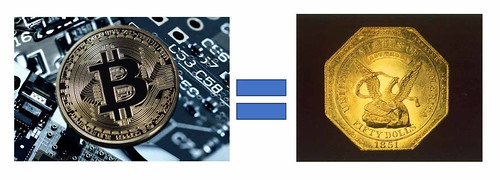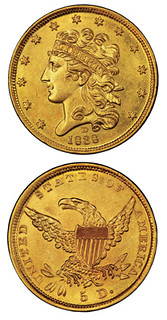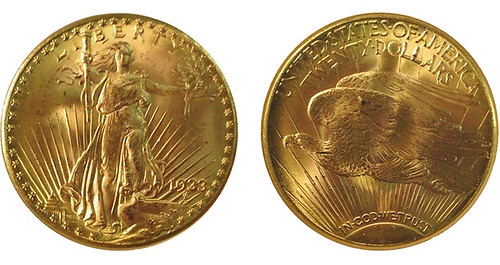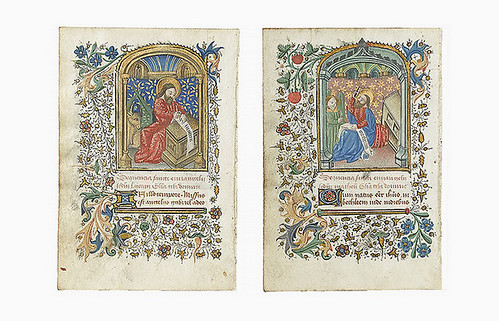
PREV ARTICLE
FULL ISSUE
PREV FULL ISSUE
Here are some additional items I came across in the media this week that may be of interest. -Editor
Kagin’s Accepting Bitcoin Kagin’s announced that they will begin accepting Bitcoins. -Editor
 Donald H. Kagin, Ph.D., president of Kagin’s, Inc. and Kagin’s Auctions announced today that their 85 –year-old numismatic firm will be accepting Bitcoins, a form of crypto-currency, in payment for their rare coins and currency inventory, as well as for auction lots in their upcoming West Coast Auction on September 21, 2018. Kagin’s has been known for decades as numismatic innovators, marketing through Amazon, the Saddle Ridge Hoard—the largest buried treasure find in North America, initiating auction cover design contests, and introducing the first numismatic loyalty program. “I love pushing the envelope by offering better ways to acquire numismatic properties and educate potential collectors to our fascinating field,” declared Kagin who earned the nation’s first B.A. and Ph.D. degrees in numismatics. “By accepting Bitcoins we can turn virtual money into a tangible asset. Not only will the new owner receive a physical medium of exchange of known value, which is both private and portable, but also can have fun doing it! “By being one of, if not the first major auction house to offer this facility, Kagin’s can pave the way for other auction houses, not only in numismatics, but for all collectables, to accept cryptocurrency. We believe that this will not only stimulate the virtual currency world but add to the demand for rare coins and currency,” predicted Kagin. A small 1% processing fee will be passed on to all Bitcoin purchases. View current inventory as well as upcoming auctions at www.Kagins.com. Or for more information contact Nina@Kagins.com or call 888-8KAGINS (852-4467). The Dahlonega Mint Bob Julian published a nice article on the Dahlonega Mint in the June 22, 2018 Numismatic News. See the complete article
online. -Editor
 If present-day collectors see a coin with the mintmark D, they automatically assume that it was struck at Denver. This was not always true,
because before 1862, this mintmark meant something quite different. Dahlonega, in northern Georgia, began striking gold coins in 1838 and continued
to do so until the work was ended by the Civil War. The story of this little-known mint began nearly two centuries ago. If present-day collectors see a coin with the mintmark D, they automatically assume that it was struck at Denver. This was not always true,
because before 1862, this mintmark meant something quite different. Dahlonega, in northern Georgia, began striking gold coins in 1838 and continued
to do so until the work was ended by the Civil War. The story of this little-known mint began nearly two centuries ago.
Gold was first discovered in the Dahlonega region in the late 1820s. In the fall of 1830, a Georgia gunsmith named Templeton Reid established a private mint and started to coin gold pieces in three denominations, $2.50, $5, and $10. He was soon out of business, however, because his assays were unreliable, and newspaper attacks made certain that everyone knew of this problem. Although Reid’s mint and coinage were soon a dim memory, the idea of a federal mint in the gold region was not; at the same time, there was agitation at Charlotte, North Carolina, for a similar institution. Powerful political forces soon backed the Southern boosters, and in March 1835, President Andrew Jackson signed into law a bill establishing not only the Dahlonega and Charlotte mints but also one at New Orleans. In far-off Philadelphia, Mint Director Samuel Moore had tried to derail the legislative process through his friends in Congress, but in the end found himself facing the inevitable. The facts of the matter were that it was far cheaper, including insurance, to send the gold to Philadelphia to be coined To read the complete article, see: The Naftzger-Browning 1933 Double Eagle Coin World published an interview with dealer Julian Leidman about his private sale of the Naftzger-Browning 1933 Double
Eagle, which was recently surrendered to the U.S. Mint. -Editor
 Professional numismatist Julian Leidman says he never had any reservations about selling, nearly four decades ago, a 1933 Saint-Gaudens double eagle. That coin is the specific coin most recently surrendered to federal authorities, its holder in fear of being accused of possessing stolen government property. Mint officials have maintained for years — and affirmed through a 2011 civil trial — that all privately held extant 1933 double eagles (except the King Farouk specimen “monetized” following its auction in 2002) are stolen government property. The Mint maintains the pieces were never monetized through official government channels, and so considers them to be chattel, not coins. Some in the numismatic community dispute the Mint’s concept of “monetized,” saying that what the Mint claims now was not the practice in 1933. Leidman, the owner of Bonanza Coins in Silver Spring, Maryland, is among those skeptical numismatists. He says he considers struck pieces of metal bearing designs, a date, denomination and country of issuance to be coins. He says he would have no qualms about buying and selling a 1964-D Peace dollar, another U.S. issue that authorities deem illegal to own since none of the 316,076 pieces struck at the Denver Mint were ever released into circulation. To read the complete article, see: What is an Illuminated Manuscript? For bibliophiles, here's an article from the Invaluable blog on illuminated manuscripts. -Editor
 Before the invention of the printing press by Johannes Gutenberg in 1439, books were crafted individually by hand. One of the most elaborate books in art history was the illuminated manuscript—a unique, handcrafted book most commonly used to recount religious scripture and lore. As the name implies, illumination is the practice of decorating book pages with glimmering gold or silver leaflets, rich pigments, intricate borders, and even elaborate paintings. These embellishments imbued text with “light” and turned each book into an elevated experience. What is an illuminated manuscript? To read the complete article, see: Wayne Homren, Editor The Numismatic Bibliomania Society is a non-profit organization promoting numismatic literature. See our web site at coinbooks.org. To submit items for publication in The E-Sylum, write to the Editor at this address: whomren@gmail.com To subscribe go to: https://my.binhost.com/lists/listinfo/esylum All Rights Reserved. NBS Home Page Contact the NBS webmaster 
|